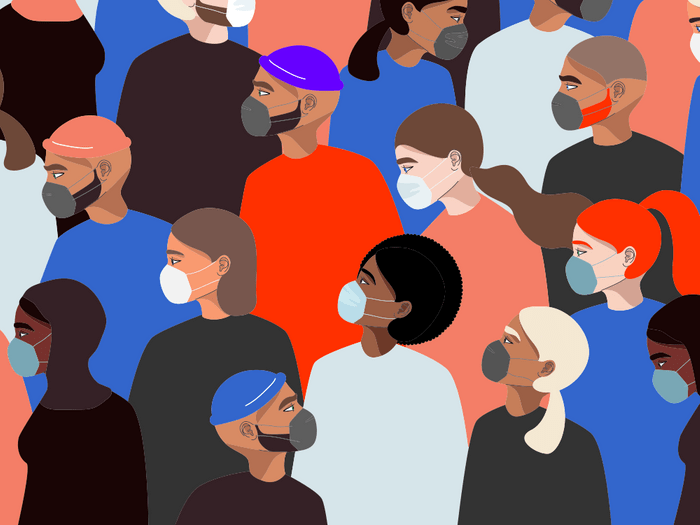Experts Advise Being ‘Super Safe’ as Canada Enters the 4th Wave of COVID

We spoke to two experts about what makes the fourth wave of COVID different, who is at risk and how Canadians can stay protected.
Despite a summer of soaring vaccination rates and plummeting COVID-19 case counts, public health officials are now warning that the fourth wave of COVID-19 has hit Canada.
“The latest national surveillance data indicate that a fourth wave is underway in Canada and that cases are plotting along a strong resurgence trajectory,” said chief public health officer Dr. Theresa Tam at an August 12 press conference.
With public health measures lifting, people are starting to return to the office, restaurants and gatherings. At the same time, the highly infectious Delta variant is spreading throughout Canada. In addition, there’s concern about kids going back to school—especially as COVID-19 cases rise within the younger populations.
So what does the fourth wave mean for Canadians who are vaccinated? What about school children who aren’t yet eligible to be vaccinated? Will we have to go back into lockdown? How do I stay protected from COVID-19?
We spoke to Dr. Anna Banerji, an infectious disease specialist at the Dalla Lana School of Public Health at the University of Toronto, and Dr. Anthony Chow, a professor emeritus at the Division of Infection Diseases at the University of British Columbia’s Department of Medicine to learn more about the fourth wave in Canada.
(Related: What You Need to Know About COVID Variants in Canada)
How will the fourth wave be different than what we’ve seen before?
The big game-changer this time around is the vaccines. According to Chow, most of the cases that are accounting for our recent uptick are in the unvaccinated population. In Ontario, for example, an August 16 report from the Ministry of Health found that 67 percent of all new cases in the province were in unvaccinated people. But, thanks to the majority of eligible Canadians being vaccinated (as of August 7, 71 percent of the total population has received at least one dose while 61 percent are fully vaccinated), “the rate [of transmission] is slower than earlier waves, when we had no protection and hardly any immunity and low vaccination rates,” says Chow.
One concerning difference between the fourth wave and previous ones, though, is the loosening of public health measures, particularly border restrictions, says Banerji. “Places in the United States really don’t have COVID under control, so we’re opening that up and unvaccinated people can come in and don’t need to quarantine,” she says. “That’s a concern.”
(Related: Moderna vs. Pfizer: Why We’re Not Playing Favourites with COVID-19 Vaccines)
Who is at risk during the fourth wave?
Generally, it’s the unvaccinated population who is most at risk. This includes both people who have not received their vaccine but are eligible and anyone under the age of 12 (or in Ontario, anyone who will not be at least 12 years of age by the end of 2021), as vaccines haven’t been approved for use in children under 12 yet. As well, young adults and teens are more at risk during the fourth wave because they have lower rates of vaccination and because they’re more likely to be working in essential services like food service or retail, says Banerji.
(Related: A Psychologist’s Guide to Preparing for Back to School 2021)
What could all this mean for our healthcare system?
During the previous waves, there was a lot of concern for our healthcare systems as hospitals filled up and surgeries were postponed when hospitals ran out of space. Banerji is hopeful that the fourth wave won’t impact surgeries and other procedures because most people are vaccinated and won’t get as sick.
Chow also hopes high vaccination rates will translate to fewer hospitalizations. “Vaccinated people still catch the virus, but they might not get sick or seriously ill,” he says. “But, transmission can still occur in the unvaccinated population, which is why social distancing and masking in spaces where you can’t distance is still very important.”
Could we be headed for more lockdowns?
Possibly. But Banerji notes that “most people would rather have mask mandates to keep workplaces and schools safe,” not lockdowns. We’re also seeing vaccination mandates and vaccine passports be discussed (and, in Quebec’s case, be implemented) as a way to, hopefully, avoid the worst of the fourth wave. Some medical professionals see mandatory vaccination for everyone as a way to address vaccine hesitancy and boost vaccination rates—and it’s already a key election issue for the upcoming federal election.
Getting vaccinated is the best way to avoid lockdowns and keep businesses open, says Banerji. Plus, it’ll keep workers and customers safe when things are open. “That’s really how we’re going to keep things open. The best way to prevent lockdowns is to get more people vaccinated.”
(Related: What You Need to Know About COVID-19 Vaccines and Your Period)
What can Canadians do to stay protected?
First of all, get vaccinated if you haven’t already. The majority of cases contributing to the current surge are in the unvaccinated population—according to a recent government of Canada count, as of July 31, 89 percent of those who contracted COVID-19 in Canada were unvaccinated while 0.6 percent were fully vaccinated. And even if you do contract COVID-19, you’re a lot less likely to get severely sick or be hospitalized if you’re vaccinated. According to that same count, 84 percent of those hospitalized with COVID-19 were unvaccinated and 0.8 percent were fully vaccinated.
Continuing with public health guidelines like masking, avoiding crowds and physically distancing will also help protect you during the fourth wave—even if your local public health unit has done away with masks and capacity limits. “It’s better to be super safe. Even if you’re vaccinated or partially vaccinated, there’s still a small chance you can get or spread COVID,” says Banerji. “I would say, hold on tight a little bit longer.”
Next, this is what you need to know about online dating and vaccines.




